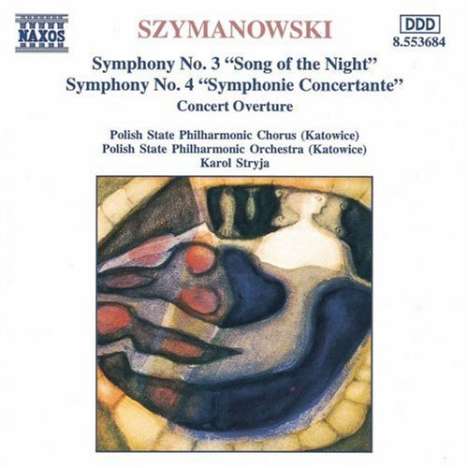Karol Szymanowski: Symphonien Nr.3 & 4 auf CD
Symphonien Nr.3 & 4
Herkömmliche CD, die mit allen CD-Playern und Computerlaufwerken, aber auch mit den meisten SACD- oder Multiplayern abspielbar ist.
(soweit verfügbar beim Lieferanten)
+Konzertouvertüre op. 12
- Künstler:
- Wieslaw Ochman, Katowice PO, Karol Stryja
- Label:
- Naxos
- Aufnahmejahr ca.:
- 1989
- Artikelnummer:
- 5776250
- UPC/EAN:
- 0730099468428
- Erscheinungstermin:
- 14.3.1997
Weitere Ausgaben von Symphonien Nr.3 & 4 |
Preis |
|---|
Szymanowskis Dritte Symphonie, 1916 nach zweijähriger Arbeit vollendet, wurde 1921 in London uraufgeführt. Das Werk, in dem Orchester und Sänger auf subtile Weise zu einem durchgehenden Klanggewebe verschmelzen, zeigt etwas vom Einfluss Debussys, vor allem aber die Neuinterpretation des Gedankens und der Worte des großen mittelalterlichen persischen Mystikers Mevlana durch den Komponisten.
Die Symphonie Concertante oder Vierte Symphonie wurde im Herbst 1932, dem Jahr ihrer Fertigstellung, unter Poznań uraufgeführt. Nach Szymanowskis eigenen Notizen über das Werk ist der erste Satz in einer Form ähnlich der Sonatenform, seine allgemeine Stimmung heiter, fast fröhlich. Der zweite Satz bietet eine breite Melodie für Flöte solo und ein Violinsolo mit Klavierbegleitung. Es gibt ein großes Crescendo, und die Musik wird ruhiger, mit dem Wiederauftauchen des Themas aus dem ersten Satz, das direkt zum letzten Satz führt, im Rhythmus eines Oberek, eines traditionellen Reigens, und analog zum Rondo in der Form, im Charakter eines sehr lebendigen, manchmal fast orgiastischen Tanzes. Das Finale enthält auch eine kurze zentrale Episode für das Klavier, eine Art Mazurka.
Die Konzertouvertüre in E-Dur wurde 1905 geschrieben und hatte sich in vielerlei Hinsicht als eine zufriedenstellendere Komposition erwiesen als die Erste Symphonie. Bei ihrer Uraufführung 1906 in Warschau wurde sie als das Werk eines Komponisten von klarer Genialität und Originalität begrüßt, obwohl sie oberflächlich betrachtet eine starke Ähnlichkeit mit dem Idiom von Richard Strauss aufweist. Es zeigt eine beeindruckende Beherrschung der Orchestrierung, eine Begabung für melodische Erfindung und harmonische Färbung und kann, obwohl es an sich dramatisch und effektiv genug ist, als ein früher Schritt hin zu einer musikalischen Ausdruckssprache angesehen werden, die aus der Welt von Wagner und Strauss herauskommen und sich zu etwas annähernd Universellem entwickeln sollte.
Product Information
Szymanowski's Third Symphony, completed in 1916 after two years work, was first performed in London in 1921. The work, in which orchestra and singers are subtly blended in a continuous web of sound, shows something of the influence of Debussy, but above all the composer's reinterpretation of the thought and words of the great medieval Persian mystic known as Mevlana.
The Symphonie Concertante or Fourth Symphony was first performed in Poznań in the autumn of 1932, the year of its completion. According to Szymanowski's own notes on the work the first movement is in a form similar to sonata form, its general mood serene, almost merry. The second movement offers a broad melody for flute solo and a violin solo with piano accompaniment. There is a great crescendo and the music grows quieter, with the re-appearance of the theme from the first movement, leading directly to the last movement, in the rhythm of an oberek, a traditional round-dance, and analogous to the rondo in form, in the character of a very lively sometimes almost orgiastic dance. The finale also includes a short central episode for the piano, a kind of mazurka.
The Concert Overture in E major was written in 1905 and had proved in many ways a more satisfactory composition than the First Symphony. At its first performance in Warsaw in 1906 it was welcomed as the work of a composer of clear genius and originality, although it bears a strong enough superficial resemblance to the idiom of Richard Strauss. It shows an impressive command of orchestration, a gift for melodic invention and harmonic colouring, and, while dramatic and effective enough in itself, may be seen as an early step towards a musical idiom that was to break away from the world of Wagner and Strauss into something more nearly universal.
-
Tracklisting
-
Mitwirkende
Disk 1 von 1 (CD)
-
1 Symphony No. 3, Op. 27, "Song of the Night"
-
2 Symphony No. 4, Op. 60, "Symphonie Concertante": I. Moderato
-
3 Symphony No. 4, Op. 60, "Symphonie Concertante": II. Andante molto sostenuto: Allegro non troppo
-
4 Concert Overture, Op. 12
Mehr von Karol Szymanowski
-
Karol SzymanowskiStabat Mater op.53CDVorheriger Preis EUR 19,99, reduziert um 0%Aktueller Preis: EUR 6,99
-
Karol SzymanowskiSämtliche MazurkenCDAktueller Preis: EUR 19,99
-
Karol SzymanowskiSymphonie Nr.2CDAktueller Preis: EUR 22,99
-
Karol SzymanowskiViolinkonzert Nr.1CDAktueller Preis: EUR 19,99








